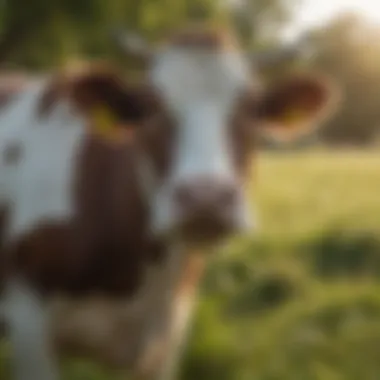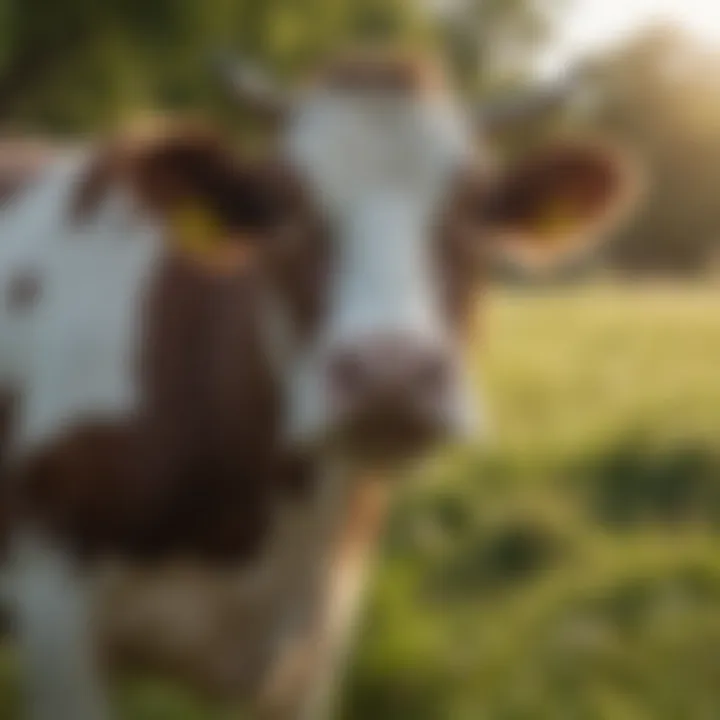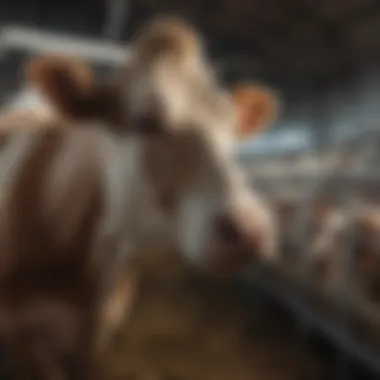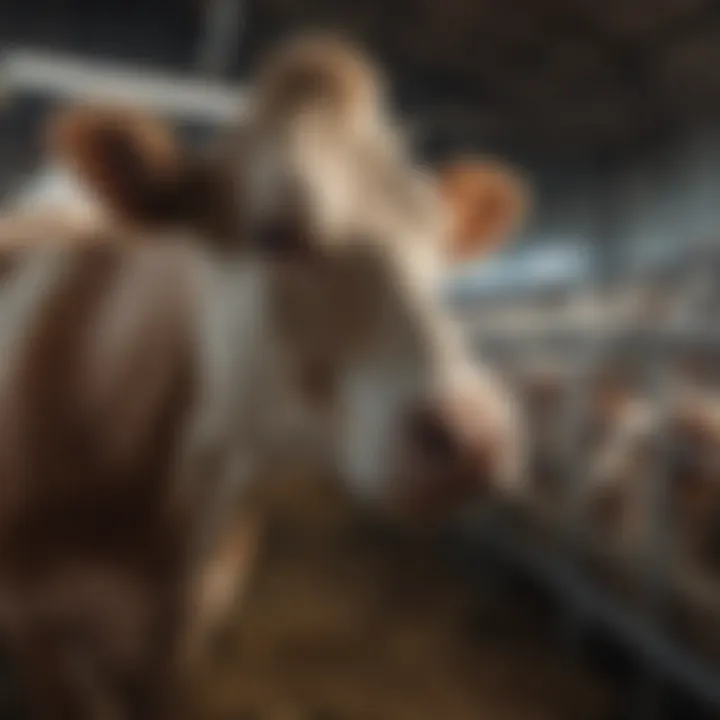Milking Dairy: Processes, Practices, Innovations


Overview of the Topic
In a world where food quality and sustainability are increasingly important, milking dairy has become a focal point of discussion among farmers and consumers alike. This intricate subject involves various aspects, from the basic processes of dairy production to the innovations that are influencing modern practices.
Definition and Importance
Milking dairy refers to the process of collecting milk from dairy animals, primarily cows, goats, and sheep. This process is not merely about obtaining milk; it also encompasses the nurturing of animals, ensuring product quality, and maintaining environmentally sustainable practices. The dairy industry plays a crucial role in global food security, nutrition, and local economies.
Understanding milking dairy is vital for several reasons. Firstly, it provides insight into how food is produced. Secondly, it highlights the developments in animal welfare, which are essential for ethical farming. Lastly, embracing modern technologies can lead to improved efficiency, which can benefit both producers and consumers significantly.
Current Trends
Today, the dairy sector is witnessing various transformative trends. Precision agriculture is emerging as a dominant approach, allowing farmers to monitor animal health and milk yield through advanced technologies. Consumers are becoming more aware of the source of their food, leading to a demand for transparency in production practices. Additionally, there is an increasing focus on sustainability, motivating farmers to adopt practices that minimize environmental impact.
Key Techniques and Practices
Understanding the methods that govern dairy production is essential. Let's delve into these key techniques and practices, which form the backbone of successful dairy operations.
Step-by-Step Guide
- Animal Selection: The choice of dairy breed is crucial. Holstein, Jersey, and Guernsey are popular choices, known for their milk yield and quality.
- Milking Routine: Regular and systematic milking schedules ensure optimal milk production. Typically, cows are milked two to three times a day.
- Hygiene Practices: Maintaining cleanliness during milking is paramount. This includes sterilizing equipment and ensuring the udders are clean.
- Milk Storage and Transportation: After milking, the milk must be cooled quickly to preserve freshness. It is then transported in refrigerated containers to processing plants.
Tools and Equipment Needed
To maximize efficiency and maintain quality in dairy farming, certain tools and equipment are necessary:
- Milking Machines: Automated systems that speed up the milking process.
- Cooling Tanks: Essential for maintaining the right temperature for milk storage.
- Health Monitoring Systems: Devices that track animal health and milk production data.
Challenges and Solutions
Like any industry, dairy farming faces numerous challenges that can impact productivity and sustainability.
Common Obstacles
- Animal Health Issues: Diseases can affect milk production and quality.
- Market Fluctuations: Prices of dairy products can vary significantly, affecting profit margins.
- Sustainability Concerns: The environmental impact of dairy farming is often scrutinized, necessitating more sustainable practices.
Innovative Solutions
Farmers are employing various strategies to address these challenges:
- Data Analytics: Utilizing data to predict market trends and adjust production strategies accordingly.
- Animal Welfare Initiatives: Implementing better animal care practices to enhance health and productivity.
- Sustainable Farming Practices: Embracing techniques such as rotational grazing and waste recycling to mitigate environmental impacts.
"The future of dairy farming depends on our ability to innovate while ensuring we uphold the highest standards of animal welfare and environmental stewardship."
As we move forward, a commitment to quality, sustainability, and innovation will define the future of dairy farming, ensuring it meets the needs of an evolving market.
For more in-depth information on dairy practices and sustainable agriculture, you can refer to sources such as Wikipedia and Britannica.
Discover further discussions and insights on dairy trends at Reddit or connect with others on Facebook.
Intro to Dairy Farming
Dairy farming is a crucial component of the agricultural sector, contributing significantly to food production and local economies. It involves the rearing of cows, goats, or other dairy animals for milk, which is an essential staple in many diets worldwide. Understanding dairy farming is fundamental because it encompasses the entire spectrum of processes, from breeding and feeding to milking and processing.
The significance of this field is mirrored in its impact on nutrition and health. Milk and dairy products provide essential nutrients such as calcium, protein, and vitamins. For many populations, these dairy foods are a primary source of these critical nutrients.
Current discussions around dairy farming also revolve around sustainability practices, animal welfare, and technological innovations. Addressing these factors not only reflects the evolving nature of the industry but also highlights the growing consumer awareness and demand for ethically produced food. Therefore, exploring dairy farming helps illuminate the complexities and advancements that contribute to this vital sector of agriculture.
Historical Perspective
Dairy farming has roots that stretch back thousands of years. It is believed the domestication of dairy animals began around 10,000 years ago. This practice quickly spread across continents, evolving with cultures and advancements in techniques over time.
Initially, milk consumption was limited to fresh milk, which meant it was not preserved for long-term use. The introduction of fermentation techniques allowed for the creation of yogurt and cheese, thereby increasing the variety and safety of dairy products. As societies progressed, so did dairy farming methods. The Industrial Revolution brought mechanization into the farming practices, setting a new standard in efficiency and productivity.
Understanding this historical backdrop is crucial as it informs current practices and innovations in the dairy industry. Techniques being developed today often find their foundation in these earlier practices, creating a blend of tradition and modernity.
Current Trends in Dairy Production
Today, the dairy industry is witnessing several trends shaping its future.
First, there is a noticeable shift towards more sustainable practices. Farmers are adopting techniques aimed at reducing their environmental footprint, like optimizing feed efficiency and improving waste management. This aligns with global efforts to address climate change.


Second, technology integration gained momentum. Robotic milking systems and data-driven approaches are enhancing productivity and animal welfare. For instance, farmers now utilize software to monitor cow health and milk production more effectively than ever before.
Lastly, consumer preferences are shifting towards organic and locally sourced dairy products, prompting producers to adapt their practices to meet these demands. This emphasis reflects a growing awareness of health, quality, and sustainability.
"The dairy industry today is at a crossroads, balancing tradition and innovation to meet the demands of a changing world."
By examining these current trends, stakeholders in the agriculture sector can better navigate the challenges and opportunities that lie ahead, ensuring a sustainable future for dairy farming.
Milking Techniques
Milking techniques are central to the dairy industry. They directly influence milk yield, animal health, and the overall efficiency of dairy farming operations. Understanding different milking methods helps improve both productivity and animal welfare. Traditional practices coexist with modern technologies, reflecting a spectrum of choices available to farmers today.
Traditional Milking Methods
Hand Milking
Hand milking signifies a time-honored approach to dairy farming. While often seen as labor-intensive, it holds benefits that deserve attention. One key characteristic of hand milking is the intimate interaction it allows between the farmer and the cow. This personal touch can lead to calmer animals, which may ultimately yield better quality milk.
Moreover, hand milking requires minimal equipment, making it an accessible choice for smaller farms. Its simplicity means that farmers can perform the task quickly with no reliance on machinery. However, there are disadvantages to consider. Hand milking is slower than machine milking and requires consistent human labor, which can be a limiting factor for scaling operations.
Milking Machines
Milking machines have revolutionized the dairy industry. Their primary contribution is efficiency; machines can milk a larger number of cows in a shorter period compared to hand milking. A significant characteristic of milking machines is their ability to automate the milking process. This reduces the labor burden and allows farmers to dedicate time to other essential tasks on the farm.
Despite their advantages, milking machines come with challenges. Initial costs for installation and maintenance can be high. Furthermore, improper use of machinery can lead to injuries in cows, highlighting the need for trained personnel to manage these systems effectively.
Advantages and Disadvantages
The advantages and disadvantages of milking techniques are crucial to understanding the dairy landscape. On one hand, traditional methods like hand milking foster a close relationship between the farmer and the animals, promoting animal welfare and potentially leading to better milk quality. On the other hand, milking machines enhance productivity and operational efficiency.
However, an over-reliance on technology could lead to neglect of animal care. The unique aspect of this balance between traditional and modern methods is their complementarity. Each has its own strengths and weaknesses, leading to varied practices in different contexts. Ultimately, choosing the right technique is determined by specific farm needs, resources, and goals.
Modern Milking Technologies
Robotic Milking Systems
Robotic milking systems represent the pinnacle of innovation in dairy farming. These systems automate the entire milking process, allowing cows to be milked on their own schedule. The key characteristic of these systems is their ability to gather data on individual cows. This data might include milk yield, animal health, and milking frequency, which can help farmers make informed decisions. As a beneficial choice, robotic systems contribute significantly to labor savings and efficiency.
Though the advantages are substantial, there are concerns as well. Start-up costs for robotic systems are often prohibitive for smaller operations. Also, technology failures can disrupt milking schedules, impacting the health of the animals and the quality of the milk.
Data-Driven Milking
Data-driven milking is reshaping how farmers approach herd management. This technique relies on technology to monitor and analyze a vast array of metrics related to the milking process. Key characteristics include real-time data collection and advanced analytics capabilities. This allows for precise assessments of cow health and milk production trends. The result is a more responsive approach to dairy management, which can lead to enhanced productivity.
However, there are challenges with data reliance. Farmers must ensure they can interpret data correctly; otherwise, it might lead to poor decision-making. Additionally, dependence on technology necessitates investment in training and infrastructure, posing a barrier for some owners.
"Integrating modern technology with traditional practices can lead to an improved overall dairy operation."
Animal Welfare in Dairy Production
Animal welfare in dairy production is a vital aspect that influences not only the quality of milk but also the overall sustainability of the dairy industry. Good welfare practices lead to healthier animals, which in turn bolster production efficiency. This connection highlights the importance of compassion in dairy farming. A focus on animal welfare goes beyond just meeting basic needs; it also includes considerations such as mental well-being and the natural behaviors of the animals.
The dairy market has increasingly emphasized animal welfare, responding to consumer demands for more ethical treatment of livestock. The benefits of good animal welfare practices include lower veterinary costs, increased milk yield, and improved product quality. Farmers who prioritize these practices often cultivate a more positive public image, which is essential in today’s environment where consumer awareness is heightened.
Animal welfare practices can significantly impact dairy production in various ways:
- Enhanced milk yield: Animals that are healthy and comfortable produce more milk.
- Reduced stress: Stress can affect milk production and quality, so minimizing it is critical.
- Better animal health: Regular health checks and proper housing contribute to fewer diseases.
"Animal welfare is not only a matter of ethics but also a key factor in the sustainability and productivity of dairy farming."
Ethical Considerations
Ethical considerations in dairy farming include the treatment of animals, the methods used in breeding, and the conditions in which they are kept. All these points contribute to the broader conversation about how society views the use of animals for agricultural purposes. It is essential to ensure that animal needs are met throughout their lives, from recreation to social interactions. This can involve providing ample space, optimal nutrition, and a climate-controlled environment.
In recent years, activists and organizations have focused on spotlighting unethical practices in the dairy industry. Improved transparency regarding the practices used in farms can help to foster trust with consumers.
The following ethical considerations are fundamental in dairy farming:
- Housing conditions: Animals should have enough space to move freely.
- Social interaction: Cows are social creatures, and isolation can cause stress.
- End of life: Ethical treatment should extend to how animals are cared for at the end of their productive lives.


Regulations and Standards
Regulations and standards surrounding animal welfare in dairy production exist to safeguard the treatment of livestock. These guidelines vary by region but often reflect a commitment to minimizing suffering and promoting healthy living conditions. In the United States, the Animal Welfare Act provides a framework outlining minimal welfare standards for livestock.
In addition to national regulations, numerous voluntary standards set by organizations like the Global Animal Partnership or Certified Humane contribute to the welfare standards that farmers adhere to. Consumers are particularly concerned about these certifications, often seeking products that align with higher welfare standards.
The following are examples of common regulations and standards:
- Housing conditions tend to emphasize space requirements and environmental control.
- Feed and Nutrition standards ensure that animals receive appropriate diet and care.
- Health management practices include regular veterinary checks and humane treatment protocols.
In summary, maintaining high levels of animal welfare is not only ethical but also advantageous to dairy farming operations. It aligns with consumer demands for ethically produced goods and ensures the long-term sustainability of this essential industry.
Nutritional Aspects of Dairy
The nutritional aspects of dairy are vital in understanding both its role in diets and broader implications for health. Dairy products provide a variety of essential nutrients that contribute to human health. In this section, we will examine the health benefits of milk and explore dairy alternatives that are becoming popular in today's health-conscious consumer market.
Health Benefits of Milk
Milk is a nutrient-dense food, rich in calcium, vitamins, and protein. Here are some key health benefits associated with milk consumption:
- Bone Health: Milk is an excellent source of calcium, which plays a crucial role in developing and maintaining strong bones. Adequate calcium intake is essential to prevent conditions like osteoporosis.
- Muscle Building: The protein found in milk, particularly casein and whey, supports muscle repair and growth. For individuals engaged in physical activities, milk is often recommended for post-exercise recovery.
- Hydration: Milk contains a high water content. It can serve as a hydrating beverage, especially in warmer climates.
- Weight Management: Some studies suggest that dairy consumption may help with weight control. The protein and fat content can enhance satiety, making one feel fuller longer.
- Nutrient Absorption: The fat in whole milk can help absorb fat-soluble vitamins A, D, E, and K more effectively.
"Milk is not just a beverage; it serves as a source of vital nutrients essential for growth and development across all age groups."
Exploring Dairy Alternatives
As the awareness of dietary restrictions and preferences grows, various dairy alternatives have entered the market. These alternatives are often derived from plants and cater to lactose-intolerant individuals or those looking for lower-calorie options. Here are some popular dairy alternatives:
- Almond Milk: Made from ground almonds and water, almond milk is low in calories and does not contain lactose. It is fortified with calcium and vitamins.
- Soy Milk: Derived from soybeans, this alternative is rich in protein and often fortified with calcium and vitamin D, making it a popular choice among vegans and lactose-intolerant individuals.
- Coconut Milk: Known for its creamy texture, coconut milk contains medium-chain triglycerides (MCTs) that can provide quick energy. However, it is lower in protein compared to other alternatives.
- Oat Milk: Oat milk has gained popularity for its smooth texture and slightly sweet flavor. It is a good source of fiber and can be beneficial for heart health.
When choosing dairy alternatives, it's essential to check labels for added sugars and nutritional fortification. Not all alternatives provide the same nutritional benefits as cow's milk, hence making informed choices is necessary for maintaining a balanced diet.
Quality Control in Milk Production
Quality control in milk production is essential for ensuring that the products meet safety and quality standards. This involves monitoring the entire dairy process, from milking to bottling, to ensure that milk is safe for consumption. Effective quality control not only protects consumers but also enhances the reputation of dairy producers.
Milk quality is affected by various factors, including animal health, milking techniques, and storage conditions. High-quality milk should appear clean, have a fresh taste, and show no signs of spoilage. Quality assurance practices help to establish a consistent level of quality, which can have significant benefits:
- Consumer Trust: High-quality milk builds consumer trust and loyalty. Customers are more likely to repurchase products they associate with quality.
- Market Competitiveness: Producers who offer high-quality milk can often charge premium prices, thus improving profit margins.
- Regulatory Compliance: Adhering to quality standards ensures compliance with health regulations and can prevent costly fines or prosecutions.
Importance of Milk Quality
The importance of milk quality cannot be overstated. Milk acts as a staple drink for many populations globally. Any issues related to quality can lead to severe health risks and economic losses for producers. Key aspects include:
- Nutritional Value: Quality milk retains its nutritional properties, such as vitamins and minerals, which are vital for consumer health.
- Safety: Contaminated or spoiled milk can lead to foodborne illnesses. Monitoring for pathogens or adulterants is critical.
- Shelf Life: High-quality milk typically exhibits longer shelf life, reducing costs associated with spoilage.
Testing and Monitoring Procedures
Thorough testing and monitoring are vital to ensure milk quality throughout the production process. This includes:
- Regular Microbiological Testing: This involves checking for harmful bacteria, ensuring that the milk meets safety standards.
- Chemical Analysis: Regular checks of fat content, proteins, and other chemical components help maintain quality standards.
- Temperature Monitoring: Milk must be stored and transported at specific temperatures to prevent spoilage. Automated systems can help maintain optimal conditions.
- On-Site Testing Kits: Handy kits allow farmers to conduct immediate checks for quality indicators at their facilities.
- Compliance Audits: Regular audits by external bodies help ensure that quality control processes meet industry standards.
"Quality control in milk production is the differentiating factor for success in competitive markets."
Environmental Impact of Dairy Farming
The significance of environmental impact in dairy farming cannot be overstated. This facet examines how dairy production affects the ecosystem. With the increase in global demand for dairy products, it becomes crucial to analyze how these practices influence land, water, and air quality. The dairy industry must balance production needs with ecological stability. Examining the environmental impact reveals opportunities for improvement, emphasizing both sustainable practices and innovation.
Carbon Footprint of Dairy Production
Dairy production contributes notably to greenhouse gas emissions. The carbon footprint consists of emissions from animal digestion, manure decomposition, and feed production. Methane, in particular, is a significant greenhouse gas produced during enteric fermentation in cattle. Its impact on global warming is considerable, being many times more potent than carbon dioxide over a shorter time frame.
To mitigate these emissions, various strategies can be employed:
- Improved Feeding Practices: Adjusting the diet of dairy cows can reduce methane emissions. Including more digestible feed helps improve efficiency and lowers emissions per unit of milk produced.
- Manure Management: Capturing methane from manure through anaerobic digesters can convert waste into renewable energy.
- Selective Breeding: Focusing on breeds that produce milk more efficiently can help lower the carbon footprint.
These actions not only support the environment but can also improve the bottom line for farmers by reducing waste and enhancing productivity.
Sustainable Dairy Practices


Sustainable dairy practices are essential for minimizing the environmental impact of dairy farming. These practices focus on reducing resource use while maintaining or increasing productivity. Important sustainable strategies in dairy include:
- Water Conservation: Implementing efficient irrigation systems and recycling water in dairy operations.
- Pasture-Based Farming: Utilizing rotational grazing helps maintain soil health and promotes biodiversity.
- Fertilizer Efficiency: Optimizing the use of fertilizers can minimize nutrient runoff, protecting water quality.
These sustainable measures not only protect the environment but also enhance the resilience of dairy farms in the face of climate change.
Incorporating these practices can provide immediate benefits to the environment and social license to operate, ensuring longevity in the dairy industry. As dairy farmers embrace sustainability, they secure a viable future for their operations while also contributing to the health of the planet.
Global Perspectives on Dairy Farming
The dairy farming industry exists on a global stage, demonstrating a variety of practices and challenges. Understanding these perspectives is crucial for grasping how local methods can influence broader market trends and sustainability goals. Each region adapts its practices based on environmental conditions, economic incentives, and cultural factors. This section sheds light on these vital considerations.
Regional Differences in Dairy Practices
Dairy farming practices vary significantly across the globe. Factors such as climate, geography, and socio-economic conditions shape how milk is produced and processed. Here are a few examples of regional differences:
- North America: In the United States, large-scale industrial farms dominate the landscape. Here, advanced technologies like automated milking systems are prevalent. Notably, there is a push for organic production, with consumers increasingly interested in ethically sourced products.
- Europe: European dairy farming is often characterized by smaller family-owned farms. This region places a strong emphasis on animal welfare and sustainable practices. Notably, countries like Denmark and Finland have implemented strict regulations to ensure the ethical treatment of livestock.
- Asia: In countries such as India, the dairy industry plays a vital role in the economy. Traditional methods still prevail in many areas, although modernization is rapidly taking place. The emphasis here is on food security, given the massive population.
These variations show how local culture and technological adoption shape dairy farming practices and could provide unique insights for other regions facing similar challenges.
Market Dynamics and Trade
Market dynamics in the dairy industry are influenced by a wide range of factors, including supply and demand, consumer preferences, and international trade agreements. Understanding these elements is key to making informed decisions within the sector.
- Supply and Demand: The demand for dairy products fluctuates, impacted by dietary trends and health awareness. For instance, plant-based alternatives are increasingly popular, challenging traditional dairy markets. However, the persistent popularity of products like cheese and yogurt remains strong.
- Consumer Preferences: Consumers are becoming more health-conscious and environmentally aware. This shift has prompted manufacturers to innovate. There is growing demand for organic, lactose-free, and fortified milk options.
- Trade Agreements: International trade plays a significant role in the dairy sector. Countries with surplus production often export to regions with higher demand. For example, New Zealand is a major exporter of dairy products, benefiting from trade agreements that open markets in Asia.
"The dynamics of the dairy market are not static; they are constantly evolving in response to consumer behavior and global economic shifts."
Future Innovations in Dairy Industry
The future of dairy farming is poised for significant transformation, driven by innovations in technology and changing consumer preferences. These advancements are not only enhancing productivity but also addressing pressing environmental issues and improving animal welfare. The integration of modern technologies facilitates better monitoring, efficiency, and sustainability. This section will elaborate on both technological developments and evolving consumer trends.
Technological Developments
Technological advancements have revolutionized the dairy industry in recent years. Farmers are increasingly integrating robotic systems, automation, and data analytics into their operations. Robotic milking, for instance, allows dairy cows to be milked on their own schedule, promoting better animal comfort and potentially increasing milk production.
Moreover, precision farming technologies such as IoT (Internet of Things) sensors track health metrics of the cows. These innovations provide real-time data that can inform farmers about feed efficiency, cow behavior, and overall herd health. This data-driven approach helps in making informed decisions, which leads to improved productivity.
In addition to robotics, the application of genetic technologies enhances breeding techniques. Selecting for specific traits in cattle leads to improved milk yield and resilience against diseases. It helps in producing animals that are more efficient in converting feed into milk, ultimately reducing the carbon footprint of dairy farming.
"The adoption of innovative technologies is crucial for the sustainability and efficiency of the dairy sector."
Another notable advancement is sustainable packaging for dairy products. With consumers becoming more aware of environmental concerns, manufacturers are shifting towards biodegradable and recyclable materials. This change not only minimizes plastic waste but also appeals to eco-conscious consumers.
Consumer Trends and Preferences
As awareness of health and environmental issues rises, consumer preferences are shifting. Many consumers are leaning towards sustainably produced dairy products. This trend has encouraged farmers to adopt more sustainable practices such as pasture-raised systems and organic farming.
The popularity of dairy alternatives, such as almond milk and oat milk, also signals a shift in the market. These products are gaining traction among health-conscious consumers. To compete, traditional dairy farmers are diversifying their product lines. They are now offering fortified milk options, lactose-free products, and even probiotic-rich dairy, catering to the needs of various consumer groups.
Additionally, transparency in sourcing and production processes has become a key demand among consumers. They seek to know where their dairy comes from and how it is produced. This shift encourages dairy farmers to adopt traceability systems and provide clear labeling. Consumers increasingly prioritize brands that show commitment to good practices and ethical standards.
Understanding these consumer trends is essential for dairy farmers as they navigate the evolving marketplace. Meeting these preferences can lead to increased customer loyalty and improved market share.
Closure
The conclusion serves as a substantial element in the exploration of milking dairy practices, summarizing the central themes discussed throughout the article. It synthesizes the insights that emphasize the integral role of dairy farming in contemporary agriculture, especially in regard to the ongoing balancing act between technology and tradition. This section helps in framing the various challenges and innovations that define the sector today.
In reviewing the historical background, current trends, and future innovations, it becomes clear that sustainable practices are not just advantageous but necessary for the longevity of dairy farming. Thus, the conclusion crystallizes key findings, offering a roadmap for farmers and stakeholders who aim to adapt in an ever-evolving market.
Addressing both the environmental impact and consumer preferences, the conclusion reflects on the complexities involved in dairy farming today. This is especially relevant to agricultural farmers and enthusiasts, who must navigate these shifts if they are to thrive in business.
Summary of Insights
Summarizing the findings from this piece, several core insights emerge:
- The traditional methods, while time-tested, are increasingly being supplemented or replaced by modern technologies.
- Dairy farming is under scrutiny regarding animal welfare and environmental sustainability, leading to stricter regulations.
- Consumers are becoming more discerning, prioritizing quality and sustainable practices when choosing dairy products.
- Innovations in dairy technologies are yielding better efficiency and production standards.
These insights provide a clear picture of where the dairy industry is heading and how it interacts with broader agricultural practices.
Call for Sustainable Practices
The call for sustainable practices within dairy production cannot be overstated. As farmers grapple with climate change effects and shifting consumer demands, adopting sustainable approaches is essential. These practices could include:
- Implementing precision farming techniques that optimize resource usage.
- Investing in renewable energy sources to decrease the overall carbon footprint.
- Prioritizing animal welfare and ethical treatment, which can improve both product quality and brand reputation.
By prioritizing sustainability, dairy farms can enhance their resilience and contribute positively to both local and global environments. The need for a collective shift towards responsible farming choices is urgent, ensuring the sector's adaptability for future generations.



